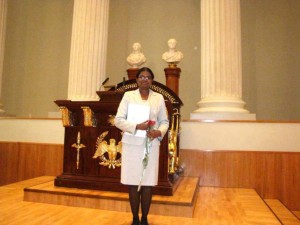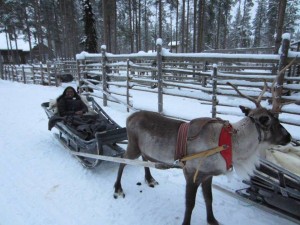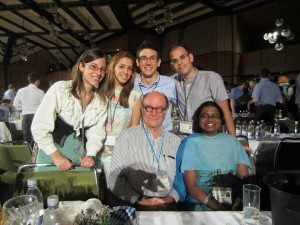Original blog link:
Meet a Bioinformatics student who met “30 Nobel Laureates”




- The Lindau Nobel Laureates meeting with Prof. Walter Gilbert who developed the DNA Sequencing methods
- Camel ride at the Canary islands
- Reindeer Safari in Lapland
- My Master’s Graduation ceremony
Let me first start with my childhood. I was born in Madurai and brought up everywhere. As my father was a bank employee, he used to get transferred every 2-3 years and we had been relocating with him. I studied in many different schools all over Tamil Nadu, which indeed gave me an opportunity to mix up with people from diverse backgrounds. Thanks to my mother, wherever I studied, she encouraged me to participate in all the competitions, which helped me to boost up my confidence.
When I was in my 10th class, we had a discussion about “Which group to choose and where to study?” Well, the direct questions were, if I should become a doctor or an engineer. I actually liked both computer science and Biology. Since we have a doctor (uncle) and 3 pharmacists (grandfather, uncle and aunt) in our family, everyone motivated me to choose biology. After endless discussions, I decided to study biology. So, my fate was decided then and everyone was looking forward to seeing me as a doctor. I was putting my utmost efforts to become a doctor. Unfortunately, my board exam marks were not as good, as I expected. Well, I secured 97.5, but the cut-off that was needed to get a MBBS seat under the government quota was 98.5 back then. Many of my relatives told me to get into some engineering college. Just because, I didn’t get a medical seat, I didn’t want to choose some random course and be happy with my life. My father always says, “Never do something that you don’t like”. I was very stubborn in my decision.
I took a break, stayed home for 1 year and wrote all possible medical entrance tests both at the state and All India level. I also used this time efficiently to interact with as many doctors and engineers as possible. One thing I figured out from their conversations was “They decided to become an engineer or a doctor, just because their parents wanted them to do so or their friends and relatives motivated them or they didn’t know what to do and chose to become an engineer”. After hearing their stories, I decided that I don’t want to be one among the crowd and I should do something different. At that point, I was happy that I didn’t get a medical seat and I didn’t choose some random engineering course that I was not interested in. Just to warn you that this is not the overall statistics. It is my perspective based on the few conversations; I have had with the engineers and doctors. I explored all possible career options with the help of resources that were available online and in newspapers. One morning, when I was having coffee with my father, he told me that he came across a course called “Bioinformatics – Solving problems in Biology with the help of computers”. I got so excited, as I wanted to study both biology and computer science. When I looked into career options for this course, I didn’t find many job opportunities in India. Since I liked the course curriculum, I opted for doing B.Tech Bioinformatics in SASTRA University. This is how I ended up in Bioinformatics.
When you have a passion for something, you will definitely excel in what you are doing. I was very happy during my B.Tech and kept my eyes open looking for opportunities. I went to many conferences, visited industries, attended many research trainings and worked as a summer research fellow. I enjoyed all these experiences and wanted to be a Master in Bioinformatics. I was in a dilemma with the questions popping up in my mind, “Where to do Masters? How to promote my career further ?”
When I was doing my 3rd year B. Tech, I got a chance to attend a Career Abroad program conducted by Mr.Sivakumar and Ms.Savitri in SASTRA. That was a life changing experience and I got to know about the Masters’ programs in many different universities across the globe. I was so excited and started preparing for GRE. In the mean time, I got placed in an IT company. I didn’t want to take up the job because I wanted to do masters. But then, the financial situation was not so favorable to start masters immediately after my Bachelor’s degree. Even my parents advised me to take up the job to gain some experience. To be frank, they were afraid to send me abroad initially. After all this drama, I started working with the intention that I will quit after 2 years. Though I took up the job, I used to think every single day that I should study Bioinformatics and shouldn’t work as a software engineer. I couldn’t handle this after 1 year. I made a bold decision to quit my job and apply for Masters.
Though my initial plan was to do my masters in US, I got to know from my friends that there are many exciting opportunities for Bioinformaticians in Europe. So, I sent my applications mainly to the universities in Scandinavia and Switzerland. I had to wait for 6 months to get the decision from the universities. I had no clues what to do during these 6 months and approached Shiva sir about getting a position in Trichy Plus. He immediately agreed and I started working there. I would say that this was one of the best experiences in my life. I really enjoyed interacting with students and helping them with their career growth. In fact, this job made me realize that communication skills are my strongest assets. Thanks to Siva sir and Savitri mam for being the mastermind behind the success of many students from Trichy. I feel so great to be a part of TRICHY PLUS.
Finally, after waiting for 6 months I got the admission letters from all the Universities, I applied. I chose University of Helsinki over other Universities because the Masters program is really flexible in Finland i.e you are free to do any course you like during your Masters, including the ones from other departments. Moreover, the quality of education is really good in Finland and it is free. Having all this in mind, I took the major step forward to accept my admission and moved to Finland.
Finland is very different from India, both climate-wise and culture-wise. I was shocked in the beginning. But then within a year, I got adapted to everything with the help of my friends. Gradually, things turned out good and I got an opportunity to do my Masters thesis in a Pharma company, where I worked on developing new computational methods to assist the design of selective drugs for cancer targets. Overall, I was very happy with my research experience and wanted to continue further.
With the support of my research supervisors, I started a PhD in Computational Drug Discovery at the University of Helsinki in 2012. Even though I have been to many conferences during my PhD, attending the Lindau Nobel Laureates meeting, where I got an opportunity to meet “30 Nobel Laureates” in the field of Medicine and Physiology was a life changing experience. The mind-blowing speeches by the great legends changed the way I think and do research. This was indeed the happiest and the best moment in my life. Though my PhD journey has been quite successful so far, I faced many challenges. The moment I think that my research is contributing to improve the strategies used in drug design, all these problems disappear like passing clouds. As a PhD student, I think it’s just the beginning. I am looking forward for much more challenges and opportunities.
In addition to doing research, I have been traveling quite a lot for the past 5 years. Every trip has been a memorable one, because of the interesting personalities I met during these trips. You learn only by experiencing things and meeting people. Whenever you get a chance to travel, utilize it.
Something that I learnt during these years, “Always pursue your passion. Success will follow you”. Whenever you are confused about making a decision, take a short break, devote some time for yourself and do what you think is right. Sometimes, it is good to satisfy others. But it’s your life. You need to decide, what is good and what is bad for you.
You can contact Vigneshwari at vignesh.bioinfo@gmail.com
https://fi.linkedin.com/in/vigneshwari-subramanian-10931749




